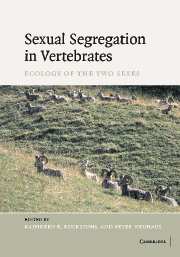Book contents
- Frontmatter
- Contents
- List of contributors
- Preface
- Part I Overview
- Part II Concepts and methodology
- Part III Foraging ecology
- Part IV Predator avoidance and reproductive strategies
- Part V Sex-related activities and social factors
- 10 Activity asynchrony and social segregation
- 11 Sexual segregation in ungulates: from individual mechanisms to collective patterns
- 12 Sexual segregation in humans
- Part VI Sexual differences in ecology: comparisons within different taxa
- Part VII Implications for conservation
- Part VIII Outlook
- References
- Index
11 - Sexual segregation in ungulates: from individual mechanisms to collective patterns
Published online by Cambridge University Press: 04 September 2009
- Frontmatter
- Contents
- List of contributors
- Preface
- Part I Overview
- Part II Concepts and methodology
- Part III Foraging ecology
- Part IV Predator avoidance and reproductive strategies
- Part V Sex-related activities and social factors
- 10 Activity asynchrony and social segregation
- 11 Sexual segregation in ungulates: from individual mechanisms to collective patterns
- 12 Sexual segregation in humans
- Part VI Sexual differences in ecology: comparisons within different taxa
- Part VII Implications for conservation
- Part VIII Outlook
- References
- Index
Summary
OVERVIEW
Sexual segregation is an integral aspect of the socio-spatial organization of ungulate populations. Very often, the social, spatial and ecological components have been confounded (Bon, 1992) and we have argued that it is necessary to define and distinguish between each of them (Bon & Campan, 1996; see also Chapter 2 by Larissa Conradt). In the present chapter, we point out that sexual segregation is a complex phenomenon that can be produced by distinct mechanisms. One of the main issues is to know whether segregation by habitats necessarily derives from sexual difference in habitat choice, or can derive from alternative causes, i.e. spatial and social mechanisms (see also Chapter 2). Habitat segregation implies heterogeneous habitat (Miquelle et al., 1992), which we assume not to be obligatory for social and spatial segregation to occur. We distinguish hypothetical mechanisms relevant only in a heterogeneous environment from those relevant in both heterogeneous and homogeneous environments. We focus on behavioural mechanisms that may generate social and spatial segregation/aggregation, and the problem of the scale at which segregation may occur. Finally, we suggest that segregation cannot only be considered as a result of individuals behaving independently of each another, but also as a result of interactions between individuals on a larger (population) scale.
Habitat versus social segregation
Miquelle et al. (1992) noted that differences in habitat selection often lead to sexual segregation and resource partitioning between the sexes.
- Type
- Chapter
- Information
- Sexual Segregation in Vertebrates , pp. 180 - 199Publisher: Cambridge University PressPrint publication year: 2006
- 3
- Cited by



